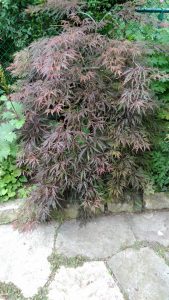
My neighbour no longer wants her Japanese maple that’s about 4′ H x 4′ W with a trunk diameter of 1 1/2-2″. When and how can I successfully transplant it?
Thank you for contacting Toronto Mater Gardeners.
What a lucky thing to adopt a beautiful Japanese Maple, Acer palmatum. It should be possible to transplant it into your yard.
If your neighbour can wait to transplant until the fall, the roots will have time to establish before winter but after the heat of summer. If not and you need to move it sooner, then you will need to monitor the tree closely as the summer can be dry and hot.
You will need to pick a sheltered location with some dappled light reaching the tree. It should be a spot that drains well, not remaining wet. The following site has information on Japanese Maples and its various hybrids: https://plants.ces.ncsu.edu/plants/acer-palmatum/
When transplanting you want the largest root ball possible. Once you have removed it take a good look at the roots. Do not be afraid to knock off or wash off the dirt to see your root structure. If there are roots growing around the plant in a circle you should tease them out so you can lay them out when you replant. Check the area around the trunk and make sure there are no girding roots that will constrict the trunk as they grow. Cut them out if you find any.
When you dig a hole for the tree ensure it is not too deep. The tree should be buried up to the spot where the trunk widens and the main roots branch off. Put roots down so they are spreading away from the trunk. Do not add any nutrients or new soil to the hole. Refill with the soil you just removed from the hole. This encourages the roots to grow away from the trunk and stabilize faster. Put mulch down in a ring around the trunk. Do not put mulch against the trunk as that encourages breakdown on the surface of the trunk.
When watering the transplanted tree check the soil first. If it is dry when you stick your finger in the soil, water it slowly and deeply. The easiest way to do this is a dripper hose around the tree on the soil surface. Run it slowly over a couple of hours.
The following site outlines everything you should think about when transplanting shrubs and trees. There has been much research in the last few years which is changing the way trees are now being planted.
https://s3.wp.wsu.edu/uploads/sites/403/2015/03/Planting-fact-sheet.pdf
Good luck and enjoy your new tree!

